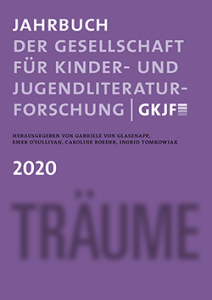Naturalistisches Träumen und irreales Wachen
Aspekte des Traumhaften in Blexbolex’ textlosem Bilderbuch »Unsere Ferien«
DOI:
https://doi.org/10.21248/gkjf-jb.51Abstract
Artikelbeginn:
[English title and abstract below]
»Nun denkt der Traum hauptsächlich in Bildern« (Freud 2008, S. 51), stellt schon Sigmund Freud 1900 in seiner Traumdeutung fest. Träumen ist nach Freud eine visuelle Erfahrung, und als solche erscheint das Bilderbuch prädestiniert, Träume darzustellen. Was von dem Abgebildeten jedoch Traum ist und was nicht, lässt sich nicht immer eindeutig bestimmen.
Naturalistic Dreaming and Unreal Waking
Aspects of Dreaminess in Blexbolex’s Textless Picturebook The Holidays
This article examines narrative forms of dreaminess in Blexbolex’s textless picturebook The Holidays (2018; original title, Nos vacances, 2017; German edition, Unsere Ferien, 2018), which tells the story of a girl who, on a visit to her grandfather, encounters an anthropomorphised elephant – an encounter which is not harmonious. In two dream sequences, the desires and fears of the protagonist are revealed and put into perspective. In this article, these two sequences are examined within the contexts of the cultural history of dreams, and their narrative functions as analeptic reflections of daily events, on the one hand, and as proleptic epiphanies, on the other. Dream elements of the fictional waking world in the frame are also considered using Stefanie Kreuzer’s typology of narrative-structural characteristics and Christiane Solte-Gresser’s examination of the conventions pertaining to how dreams are presented in picturebooks. This article asks to what extent the alleged waking world itself can be categorised as a dream world. To answer this question, it focusses on the characters’ masking and identity confusion, the motif of the dream journey as well as the presentation of the elephant, whose naturalistic appearance in the dream sequences is in marked contrast to the unrealism with which the waking world is portrayed. The conclusion reflects on the particular suitability of textless picturebooks for presenting dreams.
Downloads
Veröffentlicht
Ausgabe
Rubrik
Lizenz
Copyright (c) 2021 Jahrbuch der Gesellschaft für Kinder- und Jugendliteraturforschung

Dieses Werk steht unter der Lizenz Creative Commons Namensnennung - Nicht-kommerziell 4.0 International.





